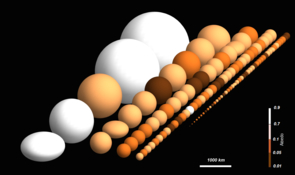The cosmic water trail uncovered by Herschel
19 September 2017
During almost four years of observing the cosmos, the Herschel Space Observatory traced out the presence of water. With its unprecedented sensitivity and spectral resolution at key wavelengths, Herschel revealed this crucial molecule in star-forming molecular clouds, detected it for the first time in the seeds of future stars and planets, and identified the delivery of water from interplanetary debris to planets in our Solar System.| Herschel: water. Click here for details and large versions of the video. Credit: ESA/Herschel/NASA/JPL-Caltech; acknowledgement: T. Pyle & R. Hurt (JPL-Caltech) |
Water is essential to life as we know it on Earth. It covers over 70% of our planet's surface and is present in trace amounts in the atmosphere. While it may seem abundant, especially if we're looking at the blue-hued stretch of a lake, sea or ocean, water is only a minor component of the total mass of Earth.
In fact, it is not at all clear whether the water that is currently present on our blue planet was there around the time of its formation, 4.6 billion years ago, or it is was delivered by later impacts of smaller celestial objects.
According to one of the leading theories to explain how the Solar System came into being, Earth and the inner planets were extremely hot and dry for the first several hundred million years after their formation. In this scenario, water was delivered to these planets only later by violent impacts of small bodies such as meteorites, asteroids, and/or comets – the remaining debris of the protoplanetary disc out of which the planets and their moons took shape.
There are various avenues to investigate the origin of this crucial molecule on our planet, either following the clues in our cosmic neighbourhood – the Solar System – or looking into the stellar nurseries where analogues of our Sun and planets are being born.
ESA's Herschel Space Observatory, an extraordinary mission that was launched in 2009 and that observed the sky at far-infrared and sub-millimetre wavelengths for almost four years, took a comprehensive approach, tracing water from stars and planets in the forming across our Milky Way galaxy to planets and minor Solar System bodies in our own neck of the woods.
Water in the Universe
Water was first detected in star-forming molecular clouds in the late 1960s. At the time, it was the sixth interstellar molecule to be identified, compared to the nearly 200 that are known to date.
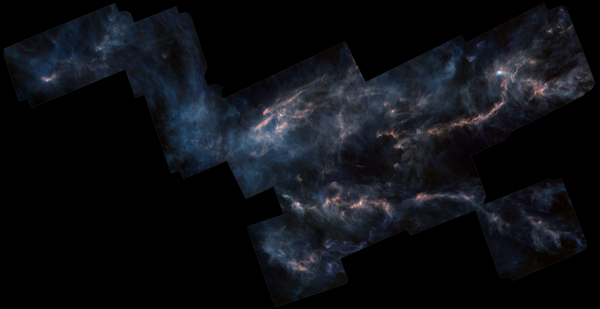 |
| Herschel's view of the Taurus molecular cloud. Credit: ESA/Herschel/NASA/JPL-Caltech, CC BY-SA 3.0 IGO; Acknowledgement: R. Hurt (JPL-Caltech) |
Ever since its discovery, astronomers suspected that water would be present in a variety of cosmic environments. After all, it is made up of the two most abundant reactive elements that exist – hydrogen, which dates back to the Big Bang, and oxygen, produced in the furnaces of stars throughout the history of the Universe.
In fact, water has been observed in celestial objects as diverse as planets, moons, stars, star-forming clouds, and even beyond our Milky Way, in the stellar cradles of other galaxies. However, due to the water vapour present in the Earth's atmosphere, studying this molecule with astronomical observations is anything but trivial.
Over the decades, astronomers have used a wide range of facilities to study water in the cosmos, from ground-based observatories in the dry climate of mountain-tops and airborne telescopes to experiments on stratospheric balloons and space observatories and even on the Space Shuttle. Far from the moist environment of our planet, a space telescope is of course the ideal tool to investigate cosmic water.
The first satellite dedicated to this topic, ESA's Infrared Space Observatory (ISO), was launched in 1995 and operated until 1998, shortly followed by NASA's Submillimeter Wave Astronomy Satellite (SWAS) and Spitzer Space Telescope, and by the Swedish-led, international Odin satellite.
Stepping into this long-established tradition, Herschel pushed the quest of cosmic water to new heights with a phenomenal piece of hardware, the Heterodyne Instrument for the Far Infrared (HIFI) – one of the three instruments on board.
To reveal the presence of a molecule in a cosmic source, astronomers look for a set of very distinctive fingerprints, or lines, in the source's spectrum, which are caused by rotation or vibration transitions in the structure of the molecule.
These lines are observed within a stretch of the electromagnetic spectrum, covering infrared to microwave wavelengths, depending on the type of molecule and its temperature. In the case of water, some of the most interesting lines – the ones that correspond to the lowest energetic configuration of water vapour, in other words its ground or 'cold' state – are found in the far-infrared and sub-millimetre ranges, which are inaccessible from the ground.
Specially designed for the hunt for water and other molecules, Herschel's HIFI instrument had an unprecedented spectral resolution that could target about 40 different water lines, each coming from a different transition of the water molecule and thus sensitive to a different temperature.
In particular, unlike its predecessors, Herschel was sensitive to two different transitions of the ground state of water that correspond to the two 'spin' forms of the molecule, called ortho and para, in which the spins of the hydrogen nuclei have different orientations. This key feature allowed astronomers to determine the temperatures under which the water formed by comparing the relative amounts of ortho and para water.
Two of the observatory's Key Programmes – Water in Star-forming regions with Herschel and Water and Related Chemistry in the Solar System – dedicated several hundred hours to the quest for cosmic water.
Exploiting the outstanding data collected by HIFI, along with observations performed with Herschel's two other instruments, the Photodetector Array Camera and Spectrometer (PACS) and the Spectral and Photometric Imaging Receiver (SPIRE), astronomers have been able to greatly expand our understanding of the role of water in the Universe.
Water in the progenitors of stars and planets
While water vapour in star-forming regions had been known for quite a while, Herschel discovered it, for the first time, in a pre-stellar core – a cold lump of dense material that will later turn into a star. The pre-stellar core, called Lynds 1544, is located in the Taurus molecular cloud, a vast region of gas and dust that is incubating the seeds of future stars and planets.
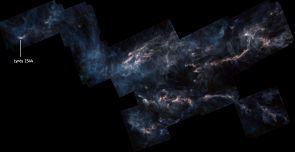 |
| Lynds 1544 in the Taurus molecular cloud. Credit: ESA/Herschel/NASA/JPL-Caltech, CC BY-SA 3.0 IGO; Acknowledgement: R. Hurt (JPL-Caltech) |
With the Herschel data, astronomers could estimate also the amount of water vapour in Lynds 1544 – the equivalent of over 2000 times the water content of Earth's oceans. The water vapour derives from icy dust grains, hinting at a reservoir of over a thousand times more water in the form of ice. If any planets are to emerge around the star taking shape from this core, it is likely that some of the water detected by Herschel will find its way to the planets as well.
En route to becoming stars, pre-stellar cores keep accreting matter from their parent cloud until they separate from it, turning into a protostar, an independent object that is collapsing under its own gravity. Normally, a rotating disc of gas and dust – a protoplanetary disc – takes shape around protostars, providing the material for the formation of future planets. Finally, when nuclear reactions ignite in the core of the protostar, counteracting the collapse, a fully-fledged star is born.
Herschel has spotted water in objects spanning all stages of star formation, including in a large number of low-mass protostars found in many nearby star-forming regions.
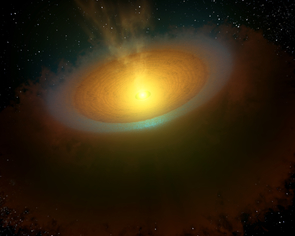 |
| Artist's impression of the TW Hydrae protoplanetary disc. Credit: ESA/NASA/JPL-Caltech |
For the first time, astronomers using Herschel have detected cold water vapour in a protoplanetary disc. While previous studies had revealed either hot water vapour in the inner part of similar discs, or water ice in their outskirts, Herschel's observations targeting the disc around the nearby young star TW Hydrae were the first to identify cold water vapour, with temperatures lower than 100 K, in such an object.
The cold vapour appears to be located in a thin layer at intermediate depths in the disc, where the evaporation of gas and the freeze-out of ice find a balance. The data indicate a small amount of cold vapour, equivalent to about 0.5 per cent of the water in Earth's oceans, but point to a much larger reservoir of water ice – several thousand Earth oceans – in the disc.
This was the first evidence that large amounts of water ice can be stored in the precursor of a planetary system like our own, thus contributing more evidence to tackling the puzzle of the origin of water on Earth and other planets.
Water in the Solar System
Besides proving that water is an important constituent of stars and planets since their early formation, Herschel also followed its trail all the way to our local neighbourhood, the Solar System.
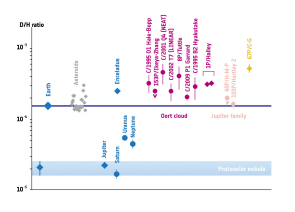 |
| Deuterium-to-hydrogen ratio in the Solar System. Credits: Data from Altwegg et al. 2014 and references therein |
To compare water found in different celestial bodies, astronomers analyse the relative abundance of molecules with a slightly different composition. Most notably, they look at the D/H ratio, comparing 'ordinary' water, composed of two hydrogen (H) and one oxygen (O) atoms, and semi-heavy water, where one of the hydrogen atoms appears as deuterium (D), an isotopical form with an extra neutron.
Before Herschel, this measurement had been performed on a handful of comets, all of them thought to originate in the Oort cloud at the outskirts of our Solar System, and all of them revealing higher proportions of deuterium to 'normal' hydrogen than that found in Earth's oceans. These results seemed to suggest that comets – icy leftovers of our ancient protoplanetary disc – could not have been the source of our planet's water, while a specific class of meteorites, called Cl carbonaceous chondrites, possessed the 'right' D/H ratio and thus seemed to be the main culprit.
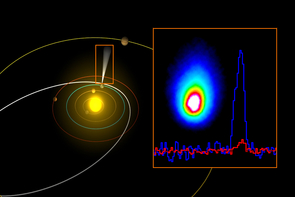 |
| Herschel image and spectrum of Jupiter-Family comet 103P/Hartley 2. Credit: ESA/AOES Medialab; Herschel/HssO Consortium |
In 2011, Herschel's observations of water in Comet 103P/Hartley 2 reopened this fascinating debate. This measurement was the first of its kind performed for a Jupiter-Family comet – a class of comets with orbits governed by Jupiter's gravity and with much shorter period with respect to their Oort-cloud counterparts – and revealed, for the first time, water with a deuterium to hydrogen proportion similar to that found on our planet.
Herschel contributed two more observations to the debate, finding a Jupiter-Family comet (45P/Honda-Mrkos- Pajdušáková) with Earth-like water, and an Oort-cloud comet (2009P1) with a different blend from that of our planet's water.
The plot thickened when ESA's Rosetta mission reached Comet 67P/Churyumov–Gerasimenko in 2014 and sampled the water content in its atmosphere. Rosetta's comet is also a Jupiter-Family one but, unlike the two observed by Herschel, it does not contain Earth-like water; on the contrary, it turned out to have the highest D/H ratio ever measured for a comet.
While Rosetta revealed that not all Jupiter-Family comets contain water that is similar to that of our planet's oceans, Herschel's earlier detections had importantly pointed out that comets with the right composition do exist and some might indeed have contributed to Earth's water budget. In fact, current models indicate that a broad and diverse range of minor bodies contributed to the critical role of bringing water to our planet.
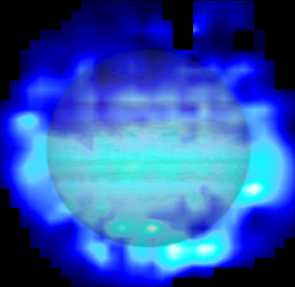 |
| Distribution of water in Jupiter's stratosphere. Credit: Water map: ESA/Herschel/T. Cavalié et al.; Jupiter image: NASA/ESA/Reta Beebe (New Mexico State University) |
Elsewhere in the Solar System, Herschel has gone as far as confirming that at least one comet has contributed to enriching a different planet – Jupiter – with water. By investigating the distribution of water vapour in the stratosphere of the giant planet, astronomers found evidence that almost all of it was delivered by the famous impact of Comet Shoemaker-Levy 9 in 1994.
Following water throughout the Solar System, Herschel has found this molecule in many more places, from the dwarf planet Ceres, the largest body in the asteroid belt, to a giant torus of water vapour surrounding Saturn, which appears to be supplied by the planet's small moon Enceladus. As revealed by the NASA/ESA/ASI Cassini mission, Enceladus exhibits plumes of water drawing from the underground ocean lurking under its icy crust.
Farther away from the Sun, Herschel revealed highly reflecting surfaces on several Trans-Neptunian Objects (TNOs), indicating that water ice might be present even on these ancient, remote objects. While TNOs date back to the early formation of our Solar System, astronomers suspect that their bright icy coating may be more recent – a speculative but not unfeasible hypothesis given the availability of water on outer planets like Uranus and Neptune, and on their major moons. Such a recent coating might also suggest that the surface of these long-thought 'dead' objects can in fact be alive, as highlighted also by the in-situ observations performed in 2015 by NASA's New Horizon probe of another TNO, the dwarf planet Pluto.
Outlook
Out to much grander scales, beyond our Solar System and the Galactic confines of the Milky Way, Herschel has detected water in many other galaxies. As already highlighted by some of its predecessors, the findings corroborate the crucial role of this all-important molecule in the processes that lead to the birth of stars throughout the cosmos.
Given its chemical composition, water unsurprisingly is ubiquitous in the Universe, and, after Herschel, there is no longer any doubt that cosmic water trails go a long way, from planets to stars, and even to the vastness of interstellar space.
However, Herschel has only begun scratching the surface of the proverbial iceberg, having spotted water in individual cosmic sources that are, in many cases, one of a kind. These exciting discoveries call for future surveys to follow up on Herschel's observations, collecting larger samples of each type of sources to scrutinise water and other molecules and delve into the physical mechanisms underlying their formation and delivery across the cosmos.
More information
Herschel is an ESA space observatory with science instruments provided by European-led Principal Investigator consortia and with important participation from NASA.
Herschel was launched on 14 May 2009 and completed science observations on 29 April 2013.
All Herschel data can be accessed from the Herschel Science Archive at http://archives.esac.esa.int/hsa/whsa/
For further information please contact:
Göran Pilbratt
Herschel Project Scientist
Directorate of Science
European Space Agency
Email: gpilbratt![]() cosmos.esa.int
cosmos.esa.int
Phone: +31-71-565-3621

